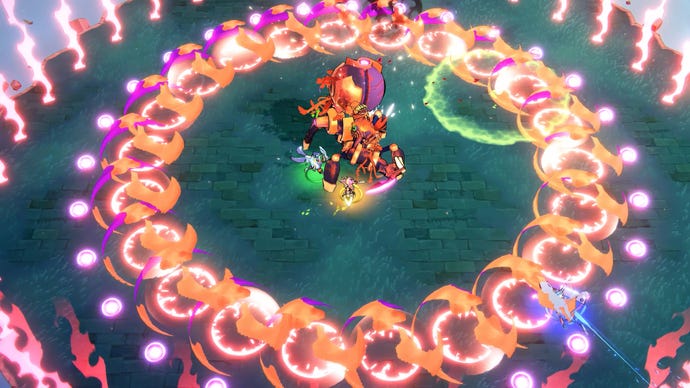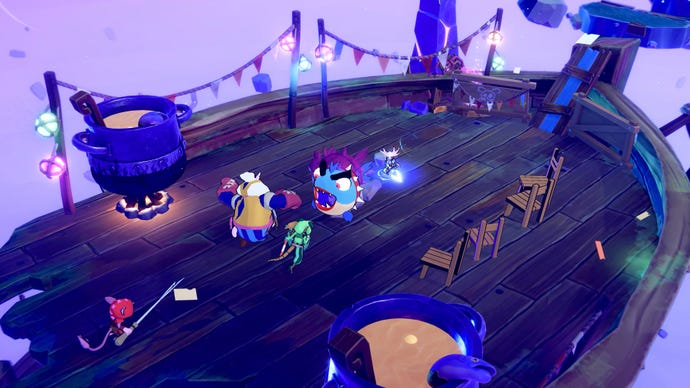The Dead Cells developer's new roguelike Windblown has a dash so potent it makes the game seem disposable
Hyper Light Speedrunner
A terrible confession: I almost fell asleep during the presentation for Motion Twin's Windblown. This wasn't really Motion Twin's fault. It was the afternoon of day four at GDC, my adrenaline reserves were spent, and there I was, in a warm, shuttered hotel room, with two men gently bombarding me with French-accented details of synergies, stackable trinkets and i-frames (I'm aware that the scenario I've just described is probably somebody's kink - let's move swiftly on).
Windblown itself is an airy, bright fusillade of Saturday morning cartoon vibes, a series of breakneck arena fights waged on procedurally generated island chains floating against a whirlpool sky. It's all shaping up very nicely, and if I'd been playing the demo, I'm sure it would have woken me up better than any emergency deluge of instant coffee. But watching somebody else tear through this stratospheric world simply overloaded my depleted senses, and I came perilously close to nodding off.
Sometimes when I fall asleep in front of a screen it invades my mind. I fell asleep playing Jedi Power Battles once and drifted off into an endless midnight plane lit by flicking green and red lightsabers. I fell asleep watching Oliver Stone's (in hindsight, astoundingly homophobic) conspiracy film JFK and for days afterward, my head was suffused with the movie's arrhythmia-inducing score. If I'd fallen asleep in front of Windblown I'm sure I would have dreamed of its dash.
Windblown has a hell of a dash. The key thing is that there's no cooldown: you can spam the button to streak through the entire layout in a zig-zag of anime energy, like Tracer chasing Widowmaker. Each biome has its open-ended sections that encourage exploration, with secret areas tucked behind destructible scenery. But at times, it feels like a race course: there are bridges and staircases of astral rock that are clearly designed to be scurried along at maximum pace, as though hammering a single chord at the end of a rock ballad in Guitar Hero.
Windblown's dash seems expressive, at times, of deep impatience towards the rest of the game, which sounds perverse on the surface, but makes sense when you consider the roguelike's intrinsic element of repetition. It's a dash dedicated to the experienced player's desire to immediately return to the biome where they last popped their clogs. There are some familiar elements that slow you down, however: boss enemies that must be fought to progress the story, and the basic pressure to defeat foes and gather new equipment, or else get your arse handed to you by an unskippable threat in the next biome along.
"It's not really about being fast, fast, fast, fast, fast, fast, fast all the time," Motion Twin's Yannick Berthier explained. "Our intention is to reach a new level, a new state of flow. We did that in Dead Cells but we want to push it further, so yes, faster but also in 3D, in a really, really different setup. And by still having pattern-based combat, it becomes like a dance with the monsters." Berthier added that, in general, "we created systems that allowed to play by just button mashing at the beginning. And then suddenly we have a bit more difficulty, and then we ramp up the skill level required."
That said, Motion Twin have had to dial back the velocity a bit during development - or at least, punctuate the flow. In the face of feedback from playtesters, the developers added onsens, aka Japanese hot springs, where you can vicariously enjoy the spectacle of your character rinsing the sweat from their body after hyperspacing the last few islands. "We made that after players told us that after 40 minutes they were like completely exhausted by the game, because it was so fast," says Berthier. "They were like 'I'm broken completely'. So we added a few pauses here and there."

Some extremely overdue scene-setting: in Windblown, you are a hyperactive cartoon animal who lives in an airborne village orbiting a vortex. The vortex is growing and it's your job to stop it, by descending through five biomes (including two alternate versions) to investigate the anomaly's heart. Seen from a delightful isometric perspective reminiscent of Supergiant's Bastion, the game's procedurally generated maps are heavily randomised - everything from loot drops through layouts to enemy position and patrol routes. Enemies include golems with assorted attachments, and some marooned pirate rats I feel a bit sorry for. Bosses have bullet hell-adjacent AOE attacks and projectile capacities, all portrayed in easily-read, but not easily avoided splats of light and colour.
The developers' previous Dead Cells aside, the game blends inspirations from more expressive and frantic Japanese action games such as Devil May Cry with the methodical preparation and pattern-reading of a Monster Hunter. "Regarding Monster Hunter, it's also a huge inspiration in the way they address multiplayer and co-op," Berthier explained. "There is not a real boundary between the two - it's as seamless as possible." Windblown has co-op for up to three, but it'll also be entirely solo-friendly, and its roguelike build-tailoring appears just as rich and open-ended as that of Dead Cells.
At the time of writing, Windblown has 11 weapon types, including throwable kunais and energy shields, 40-50 equippable gifts and a bunch of trinkets that can be stacked, combined and alchemised into sir or madam's preferred flavour of butt-kicking. There are upgrades that give you lifesteal when you dodge, status effects that make opponents explode on death, a lance that teleports you to whatever you throw it at, and a brace of overclocked "Alter" finishing moves, unlocked by mixing and matching secondary weapons.

Like Dead Cells, Windblown doesn't take itself very seriously. One of the trinkets summons a fish that can be used as a trampoline, for example. There's another fish summon that gobbles up any enemies you point it at Kirby-style, bosses included; you can hit the fish while it's digesting the meal for bonus coins. See, this is the kind of whimsy that ought to sustain a previewer's consciousness during a presentation, jetlag or no jetlag. I am a disgrace unto journalism, but then again, you knew that already.
I can’t see Windblown panning out badly, but I'm still waiting to discover what really sets the game apart from the nowadays-prosperous crowd of roguelikes with proper action game elements and very ribald presentation. The dash is the standout feature at a glance, but the three-way co-op could be the big distinguishing factor, though I already know that I'm going to forget which character I am and get myself clobbered. Here’s hoping we're actually allowed to play the game - preferably following a solid night's sleep, and perhaps, a quick dip in a real-life onsen - before it goes into early access later this year.










